Cloud Code is designed to help with editing Google Cloud and Kubernetes-related configuration files, including schema based validation, diagnostics, and quick documentation.
Supported YAML configuration files
- Anthos Config Management
- Cloud Build
- Config Connector
- Knative
- Kubernetes
- Kustomize
- Migrate to Containers
- Skaffold
Cloud Code also supports popular Kubernetes CRDs, like Kubeflow, out-of-the-box.
Enable or disable YAML support
To enable or disable YAML support, navigate to File > Settings > Tools > Gemini + Google Cloud Code > Kubernetes (for Windows and Linux) or IntelliJ IDEA > Settings > Tools > Gemini + Google Cloud Code > Kubernetes (for macOS) and select or clear the Enable YAML support checkbox to enable or disable the feature.
Use custom schema
With Cloud Code, you can provide your own CRD schema with IntelliJ settings by navigating to File > Settings > Tools > Gemini + Google Cloud Code > Kubernetes (For Windows and Linux) or IntelliJ IDEA > Settings > Tools > Gemini + Google Cloud Code > Kubernetes (for macOS) and then refer to the CRD schema locations section.
You can point to either a local file or a URL. URLs pointing to github.com are
automatically converted to raw.githubusercontent.com.
Pull schema from a cluster
When you switch to a cluster running Kubernetes v1.16+ in the
Kubernetes Explorer,
Cloud Code automatically pulls the schema of all installed CRDs.
Additional Skaffold support
Skaffold is the underlying engine that powers Cloud Code, helping you build, push, and deploy your application as well as providing support for creating CI/CD pipelines.
Cloud Code comes with additional support for managing Skaffold configuration files. When you open a project, Cloud Code detects Skaffold schemas that aren't up-to-date and prompts you (through the Event Log) when a Skaffold schema version upgrade is available for your existing Skaffold YAML configuration files.

Alternatively, you can navigate to Tools > Gemini + Cloud Code > Kubernetes > Check for Skaffold Schemas Upgrades to check for available schema upgrades.
Configure with snippets
Out-of-the-box snippets for common YAML schema (using Ctrl+Space to view options) allow you to start a new YAML file or add to an existing one without errors, while still following best practices. Additionally, it's easier to work with repetitive fields; fill in one and Cloud Code fills out the remaining instances.
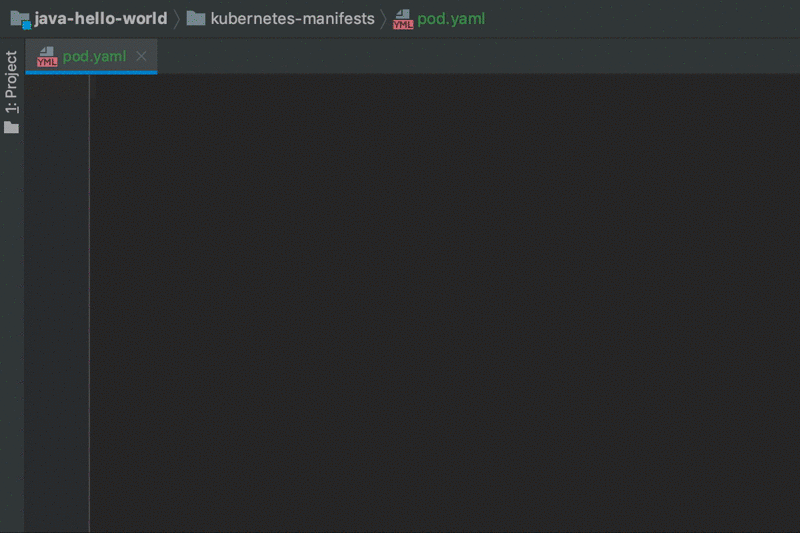
Cloud Code offers the following snippets:
Cloud Build - Cloud Run deploymentCloud Build - Docker container buildCloud Build - GKE deploymentCloud Build - GKE Skaffold deploymentCloud Build - Go buildCloud Build - Terraform plan + applyConfig Connector - BigQueryDatasetConfig Connector - BigQueryTableConfig Connector - BigtableClusterConfig Connector - BigtableInstanceConfig Connector - PubSubSubscriptionConfig Connector - PubSubTopicConfig Connector - RedisInstanceConfig Connector - SpannerInstanceKubernetes - ConfigMapKubernetes - DeploymentKubernetes - IngressKubernetes - PodKubernetes - ServiceMigrate to Containers - ExportMigrate to Containers - PersistentVolumeClaimMigrate to Containers - StatefulSetSkaffold - BazelSkaffold - Getting-startedSkaffold - Helm deploymentSkaffold - Kaniko
Complete with context
Based on the current schema, Cloud Code provides contextual completions to help you choose the right option.
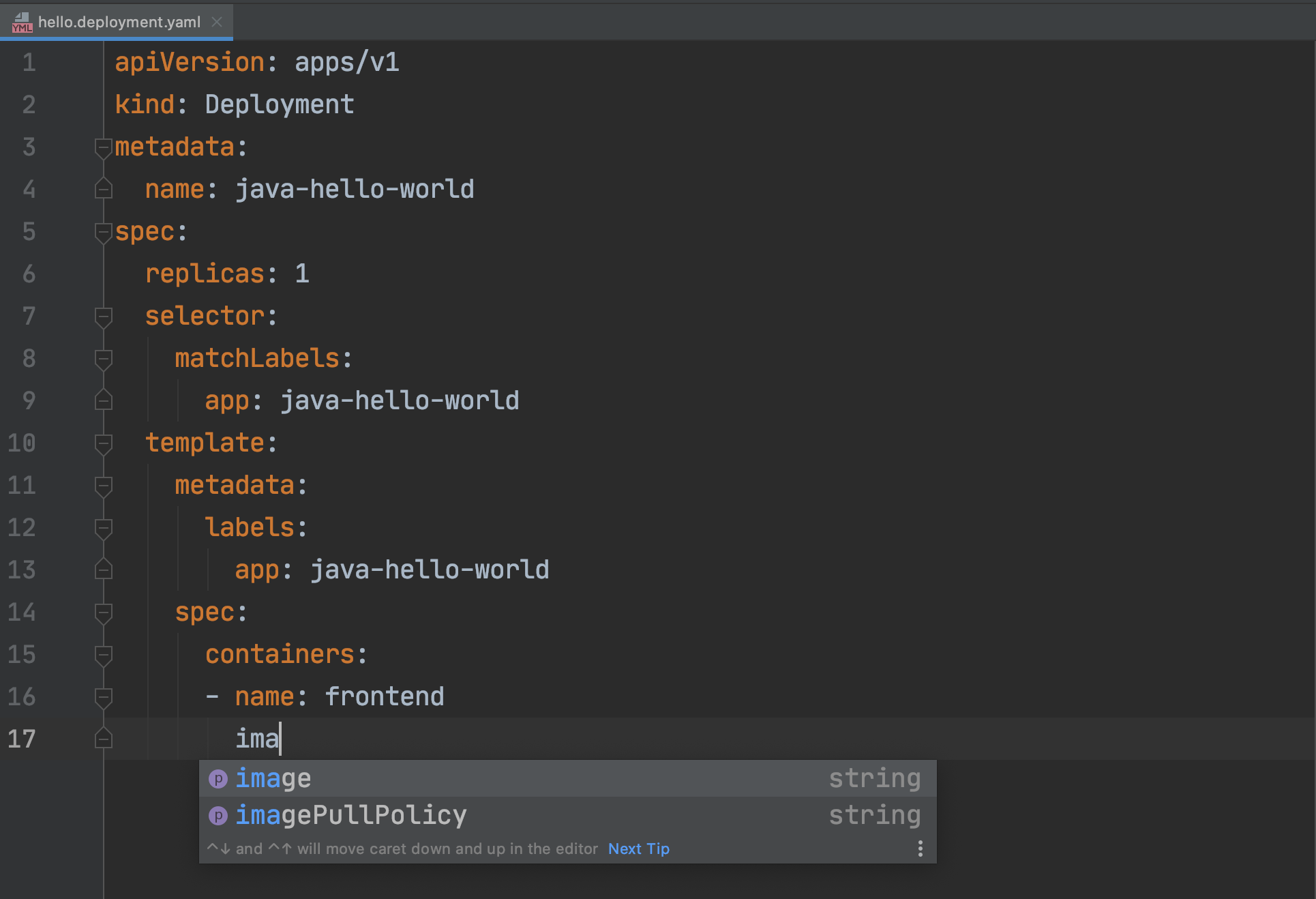
Validate YAML schema
Cloud Code offers schema validation support by flagging invalid tags and values in your YAML files and suggesting fixes when possible.
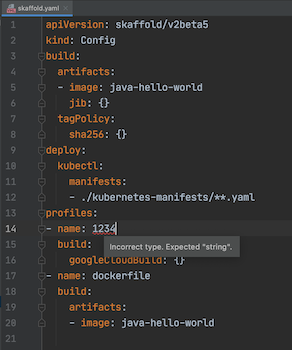
Validate Skaffold YAML files
Cloud Code provides additional Skaffold configuration file editing
support and smart templates which allow you to validate your skaffold.yaml
files. Refer to this guide on using an existing app with Cloud Code.
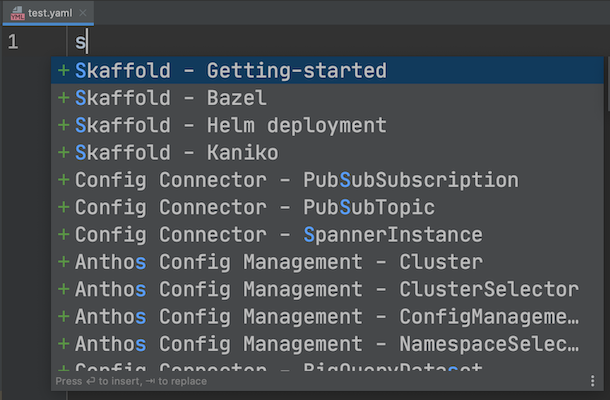
Complete Skaffold configuration files with context
Based on the current schema, Cloud Code provides contextual completions and relevant documentation to help you choose the right option.
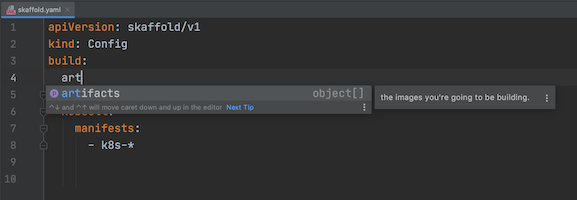
Discover definitions using quick documentation
Cloud Code surfaces relevant documentation for a resource when you highlight a line in your configuration file and navigate to View > Quick Documentation.
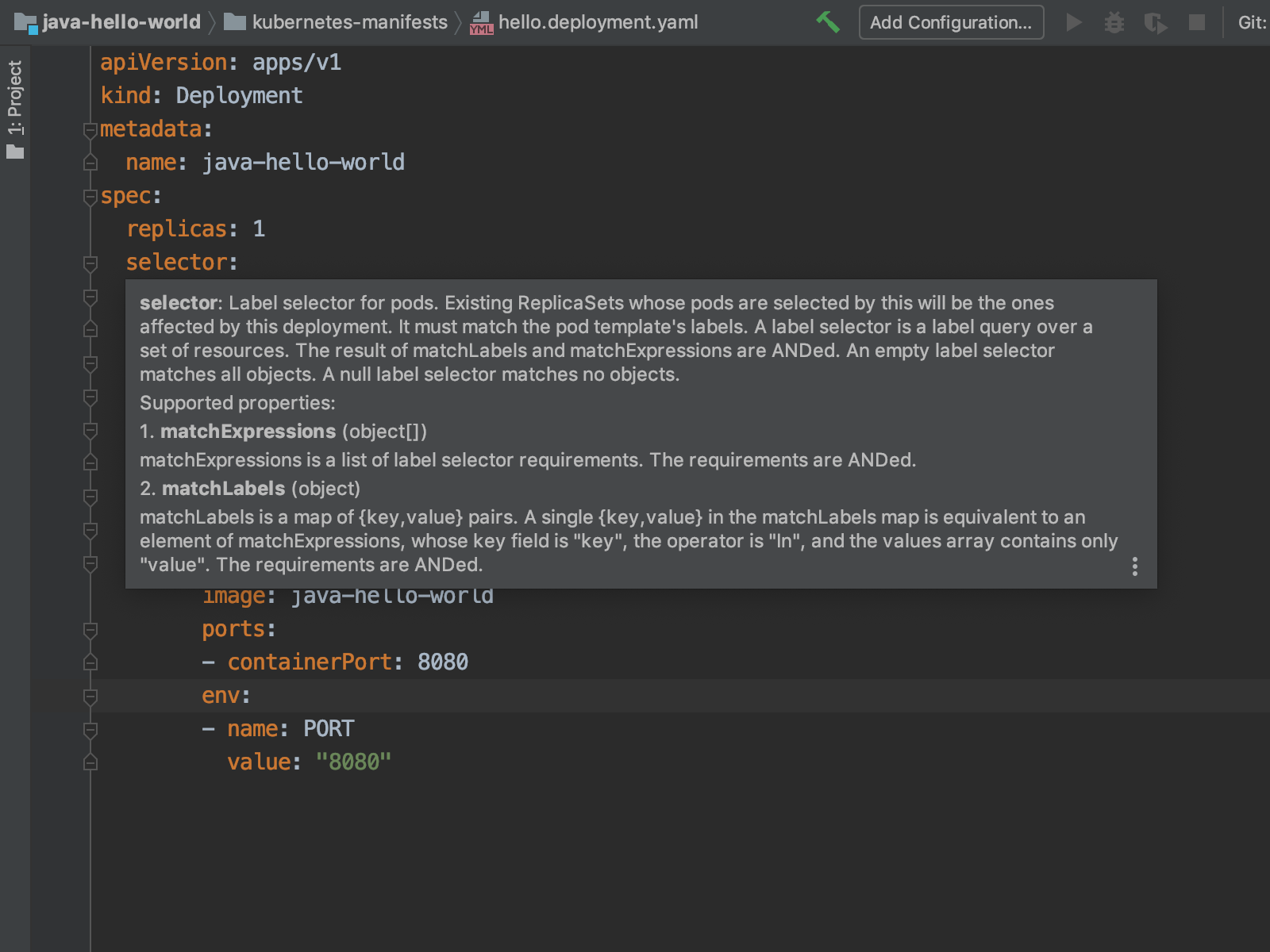
Lint YAML for structural and validity issues
Cloud Code provides linting support around common schema issues and provides descriptive errors.
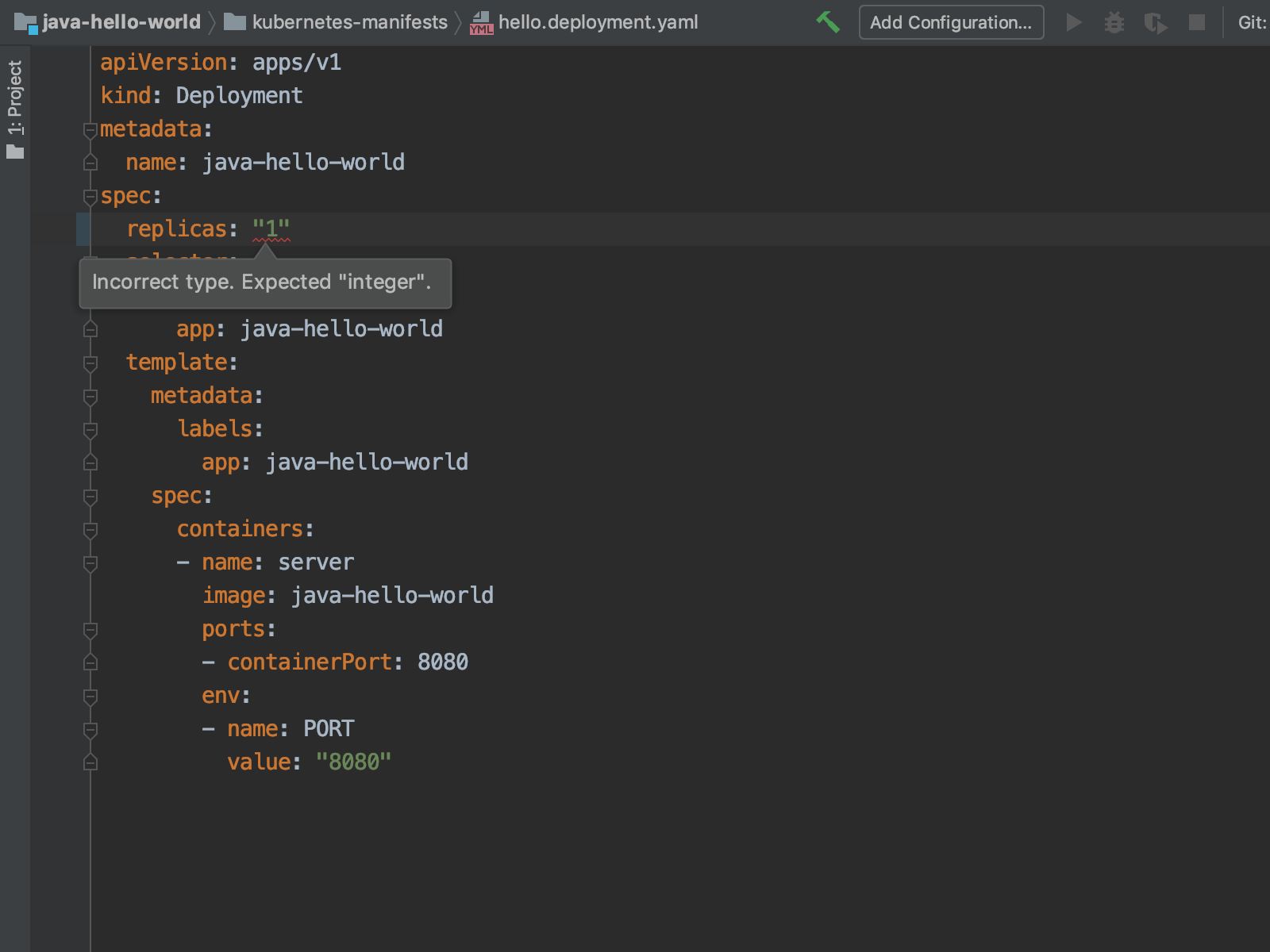
Apply a YAML file
To run kubectl apply -f to apply a configuration change using the current
file, you can use the kubectl actions icon
![]() ,
available in the gutter of your IDE, and select Apply. This brings up a diff
view for you to review changes before clicking Apply.
,
available in the gutter of your IDE, and select Apply. This brings up a diff
view for you to review changes before clicking Apply.

Diff between YAML files
To view the differences between a YAML file in source control and a deployed
YAML file, you can use the kubectl actions icon
![]() available in the gutter of your editor. Select the Diff option to see a diff
view for you to compare and contrast two schema files.
available in the gutter of your editor. Select the Diff option to see a diff
view for you to compare and contrast two schema files.

Perform a dry-run of a YAML file
To perform a dry run of your file and check its validity, you can use the
kubectl actions icon
![]() ,
available in the gutter of your IDE, to select Dry-run on Server
or Dry-run on Client. This runs
,
available in the gutter of your IDE, to select Dry-run on Server
or Dry-run on Client. This runs kubectl apply -f dry-run=server
(or kubectl apply -f dry-run=client, for the Client option) and notifies you
if your file can successfully be created in your Terminal window.
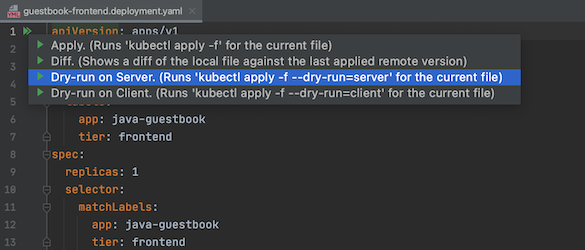
What's next
- Create a
Cloud Code Kubernetes run configuration
skaffold.yamlfile. - Manually create a Skaffold configuration for your application.
- View the
Skaffold.yamlreference docs.
